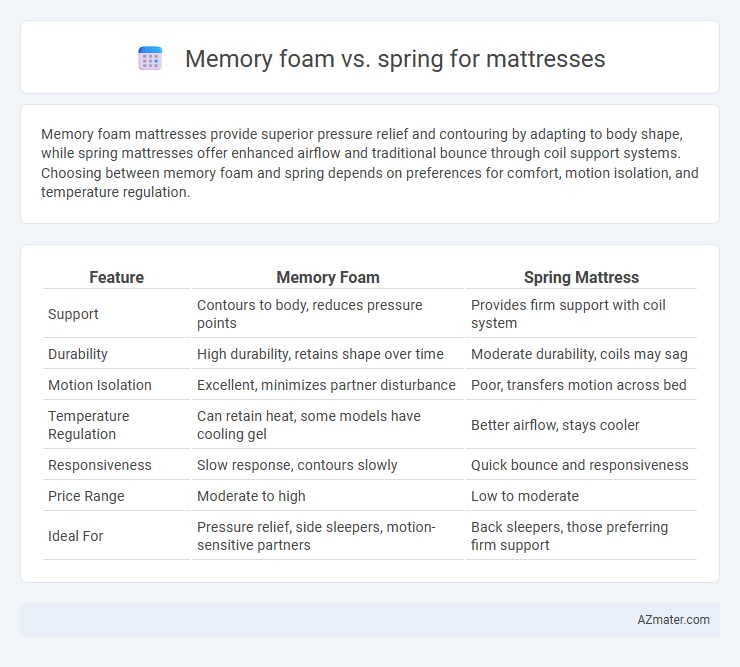Memory foam mattresses provide superior pressure relief and contouring by adapting to body shape, while spring mattresses offer enhanced airflow and traditional bounce through coil support systems. Choosing between memory foam and spring depends on preferences for comfort, motion isolation, and temperature regulation.
Table of Comparison
| Feature | Memory Foam | Spring Mattress |
|---|---|---|
| Support | Contours to body, reduces pressure points | Provides firm support with coil system |
| Durability | High durability, retains shape over time | Moderate durability, coils may sag |
| Motion Isolation | Excellent, minimizes partner disturbance | Poor, transfers motion across bed |
| Temperature Regulation | Can retain heat, some models have cooling gel | Better airflow, stays cooler |
| Responsiveness | Slow response, contours slowly | Quick bounce and responsiveness |
| Price Range | Moderate to high | Low to moderate |
| Ideal For | Pressure relief, side sleepers, motion-sensitive partners | Back sleepers, those preferring firm support |
Memory Foam vs Spring Mattress: An Overview
Memory foam mattresses contour to the body, offering superior pressure relief and motion isolation compared to traditional spring mattresses, which provide a bouncier feel and enhanced airflow. Memory foam's viscoelastic properties help reduce joint pain and improve spinal alignment, making it ideal for individuals with chronic pain conditions. Spring mattresses, often constructed with pocketed coils, promote breathability and durability but may transfer more motion, affecting sleep quality for couples.
Key Differences in Construction
Memory foam mattresses consist of multiple layers of viscoelastic foam designed to contour closely to the body, providing pressure relief and even weight distribution. In contrast, spring mattresses feature a core of metal coils or springs that offer bouncy support and promote airflow, helping to regulate temperature. The fundamental construction difference lies in memory foam's solid, adaptive structure versus spring mattresses' resilient, open coil system.
Comfort and Support Comparison
Memory foam mattresses contour to the body's shape, providing pressure relief and minimizing motion transfer, which enhances comfort especially for side sleepers. Spring mattresses offer robust support with better airflow due to coil construction, promoting a cooler sleep environment and firmer feel preferred by stomach and back sleepers. Comparing support, memory foam evenly distributes weight to reduce pressure points, while spring mattresses provide dynamic support with responsive bounce for easier movement.
Motion Isolation: Which Mattress Excels?
Memory foam mattresses excel in motion isolation due to their ability to absorb and contour around body movements, minimizing disturbance between sleep partners. In contrast, spring mattresses, especially those with interconnected coils, tend to transfer motion more readily, causing potential disruptions during the night. Hybrid models with individually wrapped coils can improve motion isolation but generally do not match the performance of high-density memory foam in reducing motion transfer.
Temperature Regulation and Breathability
Memory foam mattresses often retain heat due to their dense structure, leading to lower breathability and potential discomfort for hot sleepers. In contrast, spring mattresses feature an open coil design that promotes better airflow, enhancing temperature regulation and keeping the sleeping surface cooler. Advanced memory foam variants with gel infusions or open-cell technology improve breathability but generally cannot match the natural ventilation of traditional spring systems.
Durability and Lifespan Factors
Memory foam mattresses typically offer superior durability with an average lifespan of 7 to 10 years due to their dense material composition that resists sagging and body impressions. In contrast, spring mattresses usually last around 5 to 8 years, as coil systems can wear out faster and lose support over time. Factors such as foam density, coil gauge, and user weight significantly influence the longevity and overall durability of both mattress types.
Pressure Relief and Spinal Alignment
Memory foam mattresses contour closely to body curves, providing superior pressure relief by evenly distributing weight and reducing stress on joints. Spring mattresses offer firmer support and better airflow but may create pressure points due to uneven distribution, potentially compromising spinal alignment. For optimal spinal alignment and pressure relief, memory foam mattresses are generally preferred by those with chronic pain or alignment issues.
Suitability for Different Sleep Positions
Memory foam mattresses contour to the body's shape, providing ideal support for side sleepers by relieving pressure points and aligning the spine. Spring mattresses offer a firmer and more responsive surface, beneficial for back sleepers who require even weight distribution and support. Stomach sleepers may prefer spring mattresses to prevent excessive sinking, maintaining proper spinal alignment and reducing discomfort.
Allergen Resistance and Maintenance
Memory foam mattresses offer superior allergen resistance by naturally repelling dust mites and preventing the accumulation of mold and pet dander, making them an excellent choice for allergy sufferers. In contrast, spring mattresses have more gaps and crevices that can harbor allergens, requiring frequent cleaning and maintenance to minimize buildup. Memory foam is also easier to maintain, as its dense structure resists sagging and deformation, whereas spring mattresses may need regular checks for coil wear and foundation support.
Price Range and Value for Money
Memory foam mattresses typically range from $500 to $2,000 depending on density and brand, offering excellent pressure relief and motion isolation that enhance sleep quality and justify the cost for many users. Spring mattresses generally cost between $300 and $1,500, providing strong support and better airflow but sometimes lacking in contouring comfort, making them a budget-friendly choice for those prioritizing durability and breathability. Evaluating value for money involves balancing comfort preferences, durability, and price sensitivity, with memory foam excelling in personalized comfort and spring mattresses delivering traditional support at a lower price point.

Infographic: Memory foam vs Spring for Mattress
 azmater.com
azmater.com